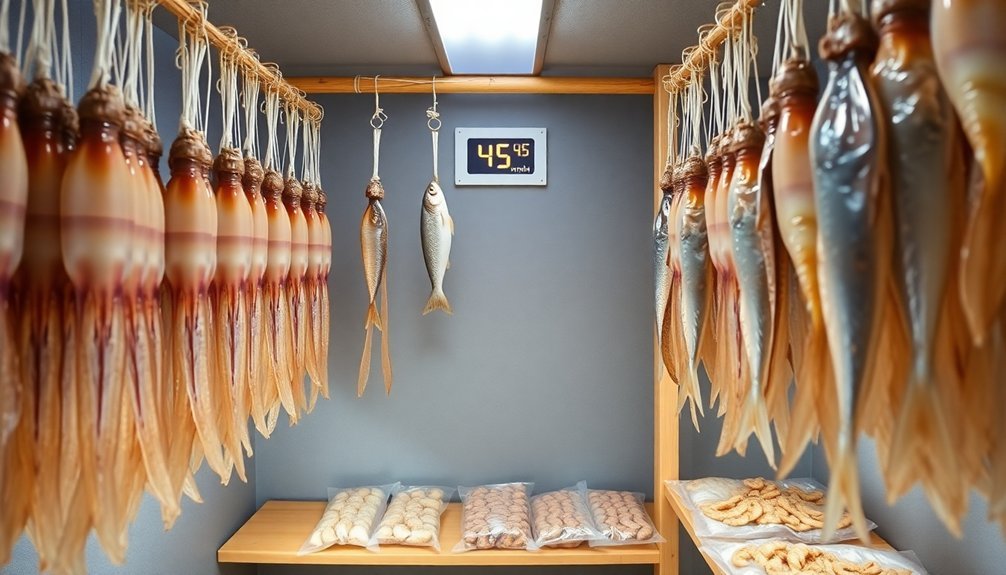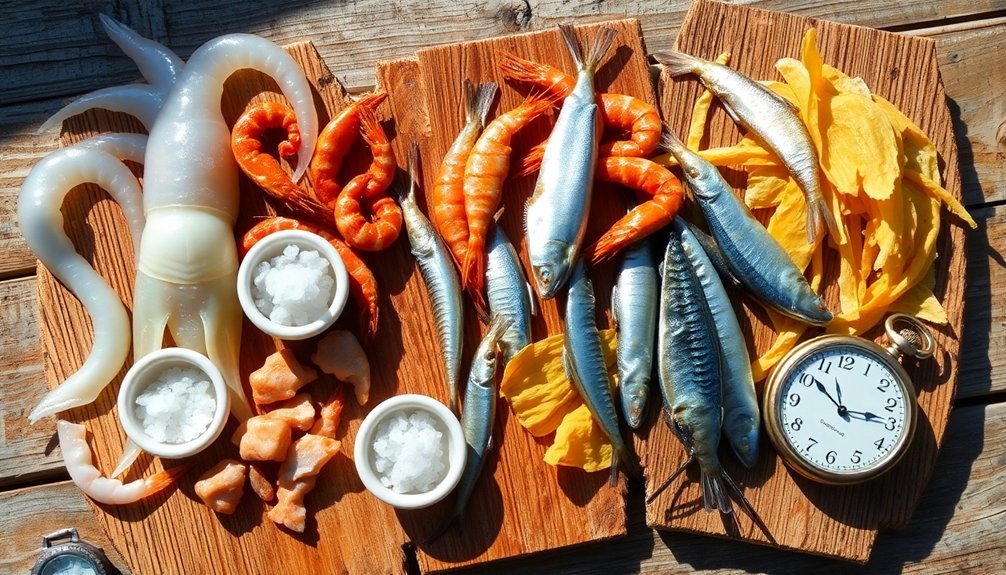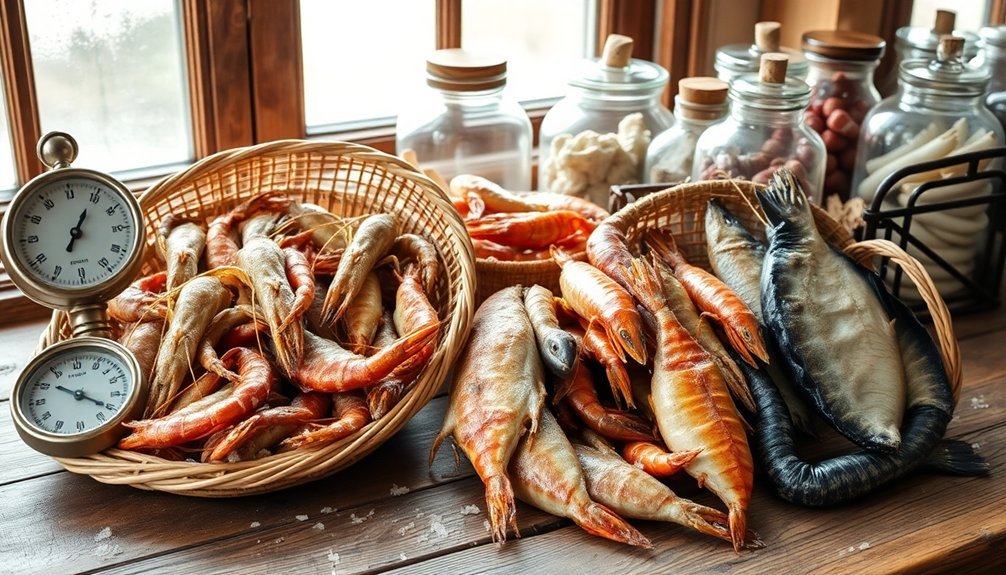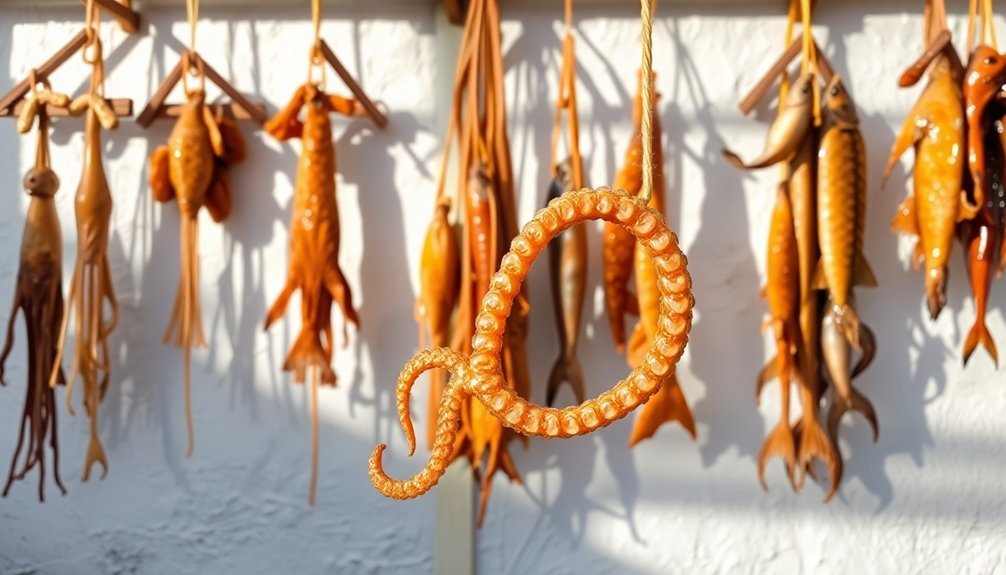Your air-dried seafood can stay fresh for 6-12 months when stored correctly. Store it in a cool, dry environment below 70°F (21°C) and maintain low humidity levels to prevent rehydration. You'll want to use proper packaging with strong gas barrier properties and consider vacuum sealing for maximum preservation. Watch for warning signs of spoilage like strong odors, soft spots, or discoloration. Always keep your dried seafood in airtight containers and label them with storage dates. While these basics will get you started, proper preservation techniques can help you extend shelf life even further.
Optimal Storage Environment

Proper storage conditions are vital for maintaining the quality of air-dried seafood. You'll need to store your products in a cool, dry environment where temperatures remain consistent and below the dew point to prevent unwanted rehydration. Similar to frozen seafood storage, maintaining consistent temperatures throughout storage is crucial for preserving quality. While refrigeration isn't necessary for shelf-stable items, you can use it to control specific pathogens in certain products.
Your storage area must maintain low humidity levels, which is important in preventing moisture absorption. If you're in a humid climate, you'll want to use desiccants or dehumidifiers to maintain ideal conditions. It's significant to monitor humidity levels regularly and use moisture-proof storage materials to protect your dried seafood.
Confirm you're storing your products in a well-ventilated area away from direct sunlight, and keep them elevated off the floor to guarantee proper air circulation.
Don't stack items too high, as this can restrict airflow and potentially damage the products. You'll also want to use modern packaging materials like plastic films or laminates to protect against oxygen exposure and insect infestation.
Regular inspections for signs of pests or contamination will help maintain product quality throughout storage.
Packaging for Maximum Freshness
Selecting the right packaging materials plays an essential role in preserving air-dried seafood's freshness and quality. In order to maximize shelf life, you'll want to use packaging with strong gas barrier properties, such as polyamides or PVDC, which prevent moisture and oxygen from compromising your product. Professional seafood processors often rely on tailored MAP solutions to optimize their preservation methods.
For the best protection, choose multi-layer packaging that combines different materials. Look for high-barrier co-extruded bags that include EVOH and LDPE layers, as these provide excellent gas barrier properties while ensuring proper heat sealing.
If you're packaging fatty fish products, opt for oil-resistant films to prevent package deterioration.
You'll need to reflect upon modified atmosphere packaging (MAP) for extended preservation. This technique replaces regular air with a specific gas mixture containing carbon dioxide, nitrogen, and controlled levels of oxygen. CO₂ levels above 20% will help inhibit bacterial growth, while nitrogen prevents rancidity in oily fish products.
Don't forget to include absorbent pads made of cellulose in your packaging to manage moisture and reduce bacterial growth.
For transport, use insulated containers like EPS boxes to maintain consistent temperature and protect your air-dried seafood from mechanical damage.
Common Shelf Life Timeframes

Most air-dried seafood products maintain their quality for 6-12 months when stored correctly. Different types of seafood have varying shelf life spans, with fish typically lasting the longest at up to 12 months. You'll find that shellfish, shrimp, squid, and other crustaceans generally stay fresh for 6-9 months when properly stored. Using airtight containers prevents oxygen exposure and helps maintain food quality, similar to how freeze-dried foods are preserved.
To maximize shelf life, you'll need to store your dried seafood at temperatures below 70°F (21°C) in a low-humidity environment. Keep your products in airtight containers away from direct sunlight, and handle them minimally to prevent contamination.
| Type of Seafood | Shelf Life | Storage Requirements |
|---|---|---|
| Fish | 6-12 months | Cool, dry, dark place |
| Shellfish | 6-9 months | Airtight container |
| Shrimp | 6-9 months | Below 70°F (21°C) |
| Squid/Octopus | 6-9 months | Low humidity |
| Crustaceans | 6-9 months | Minimal handling |
Remember to label your containers with the storage date and rotate your stock regularly. You'll know it's time to discard your dried seafood if you notice any unusual odors, mold growth, or significant color changes.
Detecting Spoilage Warning Signs
While storing your dried seafood correctly helps extend its shelf life, knowing how to spot signs of spoilage can protect you from consuming unsafe products. You'll need to rely on your senses to detect warning signs, particularly your sense of smell and sight.
Check for any strong, unpleasant odors that differ from the typical mild, briny scent of seafood. If you notice ammonia-like or rancid smells, it's time to discard the product. The texture should be firm and consistent – if you find soft spots or mushiness, that's a clear indication of spoilage.
When examining dried seafood visually, look for any discoloration or dark spots that weren't present when you purchased it. The product should maintain its original color and appearance. If you're dealing with whole dried fish, the eyes should be clear, not clouded, and the gills shouldn't show signs of deterioration.
Pay attention to the packaging integrity as well. If you notice tears, holes, or compromised seals, there's a risk of contamination.
When in doubt about your dried seafood's safety, it's better to err on the side of caution and dispose of questionable items.
Best Preservation Methods

The key to maximizing your dried seafood's shelf life lies in choosing the right preservation method for your needs. You'll find that combining traditional drying with modern storage techniques offers the best results. For ideal preservation, you can pair air-drying with vacuum sealing or use a combination of salting and smoking before storage.
| Method | Storage Life | Best For |
|---|---|---|
| Air-Drying + Vacuum Seal | 6-8 months | Fish, squid |
| Salting + Smoking | 4-6 months | Fatty fish |
| Freezing After Drying | 12+ months | All seafood |
| MAP Storage | 3-4 months | Dried shellfish |
| Traditional Drying Only | 2-3 months | Small fish |
Remember to store your preserved seafood in airtight containers and keep them in a cool, dry place. If you're using refrigeration, maintain temperatures between 0°C and 4°C for chilled items and below -18°C for frozen products. For enhanced protection against moisture and bacteria, you can use oxygen absorbers in your storage containers. When dealing with larger quantities, consider dividing them into smaller portions to minimize exposure to air and moisture during access.
Frequently Asked Questions
Can I Rehydrate Air-Dried Seafood, and How Does It Affect Taste?
You can rehydrate air-dried seafood using boiling water or overnight soaking. When done properly, it'll restore the seafood's natural texture and flavors, but be careful not to overcook it after rehydration.
Does Freezing Air-Dried Seafood Affect Its Nutritional Value?
When you freeze air-dried seafood, you'll retain about 97% of its nutrients. While some vitamin C and B1 may decrease slightly, the protein content and most other nutrients stay well-preserved during freezing.
Is It Safe to Consume Air-Dried Seafood After Cutting Away Moldy Parts?
No, you shouldn't eat air-dried seafood with any mold. Even after cutting away visible moldy parts, harmful toxins and hidden mold can remain throughout the product. It's best to discard the entire item.
Can I Make Air-Dried Seafood at Home Without Specialized Equipment?
Yes, you can make air-dried seafood at home using your regular oven on low heat. Just guarantee good airflow, slice seafood thinly, and maintain consistent temperature. A food thermometer helps monitor conditions.
Why Does Some Air-Dried Seafood Develop White Crystals on the Surface?
You'll notice white crystals on your air-dried seafood because natural minerals like calcium and magnesium carbonates precipitate out as water evaporates. They're harmless and often appear during the drying and curing process.
In Summary
With proper storage and handling, you'll enjoy your air-dried seafood for months to come. Keep it in airtight containers, maintain consistent temperatures, and check regularly for any signs of spoilage. Don't forget to store it away from direct sunlight and moisture. When in doubt about freshness, trust your senses – if something looks, smells, or feels off, it's better to discard it than risk foodborne illness.





Leave a Reply